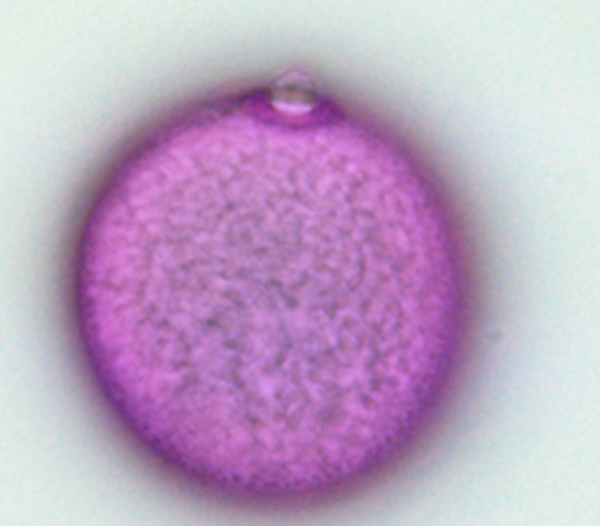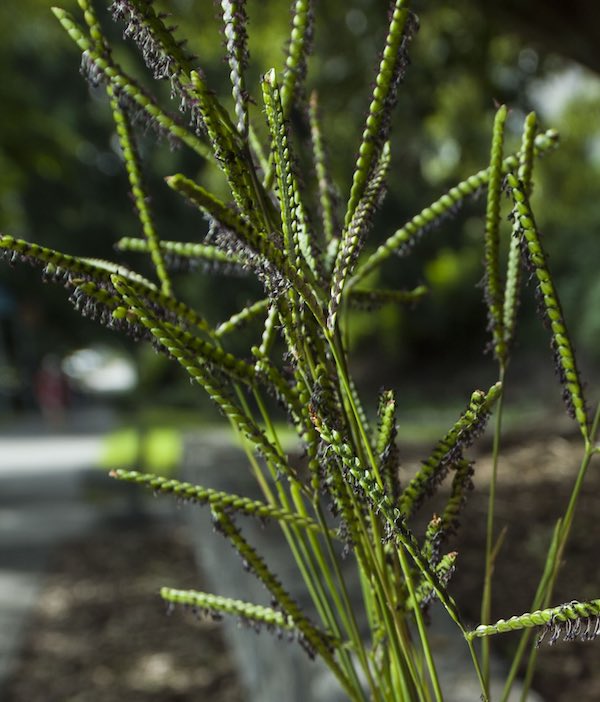FAQ
What is pollen?
Pollen is the fine powdery substance released by anthers, a part of the flower. Pollen grains contain the male gametes of plants and are analogous to the male sperm cells in humans.
Why is pollen a problem?
Pollen of wind-dispersed species such as grasses, especially subtropical grasses like Bahia, Bermuda, Rhodes and Johnson grasses (common in subtropical regions of Queensland) is small in size (25-40 microns), round in shape, and is dry, yellow powder. Pollen from certain plants can trigger allergic reponses in sensitised individuals. Whole pollen grains landing in the eyes or nasal passages can trigger hay fever, characterised by a blocked or runny nose, sneezing and itchy eyes. Hay fever affects as many as 19% of the Australian population including 15% of Queenslanders.
Fragments of allergic pollen grains are small enough to enter the lower airways and can trigger asthma in a sensitized person, causing their airways to narrow and making it harder for them to breathe. Around 1 in 9 Australians has asthma Including 11.2% of Queenslanders.
Why count pollen?
Counting the levels of pollen in Brisbane’s air means we can tell people who suffer from allergic conditions, such as hay fever and asthma, of days that are forecast to have high and/or extreme pollen levels. This information allows people to take preventative measures such as staying indoors, preventative intranasal (for hayfever) or inhaled (when prescribed by a doctor for asthma) corticosteroids, anti-histamines, or having their asthma reliver medication close at hand.
Why grass pollen?
Grass pollen makes up around 60-70% of all the pollen observed in air in Brisbane. Because grass pollen is the major allergic pollen type in Brisbane, our forecasts focus on grass pollen. In Brisbane with a subtropical climate, the common types of grasses flower throughout summer and autumn, as well as spring. For this reason, we begin counting in November when grasses start flowering and levels of grass pollen in the air start to rise. During the grass pollen season, the count is done daily and the information distributed on this website, or our Facebook page.
How is pollen monitoring done?
For the collection of pollen, air is sampled with an air sampler called Burkard Volumetric Spore Trap located at the Queensland Government Department of Environment and Science (DES) air quality monitoring station at Oxley Creek Common, Rocklea (Brisbane’s southside). This device captures airborne pollen on tosticky tape attached to a drum that rotates past the air inlet. Back in the lab, we take the tape off the exposed drum and mount it onto a microscope slide, which we stain with a purple dye that allows us to see pollen grains and count them using a microscope. We count all types of pollen seen on the slide, not just the grass pollen. The count is given on a scale from low to extreme, and as actual concentration values of grass and other kinds of pollen (as grains per cubic metre of air) caught in the trap in the previous 24 hours.
Our research team has developed a pollen forecast model that is based on the pollen concentration in the air and on the weather forecast, as well as on the remote sensing information from satellites. The pollen concentration and forecast are shared with health professionals and people in the community at the same time each day (at about 11am).
What factors affect the daily pollen count?
A number of factors affect the daily level of grass pollen in the air, including fluctuations in temperature, wind conditions, humidity and precipitation, and the biology of the grasses themselves.
Whilst most temperate grasses in Queensland flower in late spring and early summer, subtropical grasses also flower throughout summer and autumn. Grass production tends to follow summer rainfall in Brisbane. During the flowering season, weather conditions such as wind and humidity will also affect daily pollen levels of grass pollen is in the air.
Is the pollen season the same from year to year?
The beginning and end of the grass pollen season is variable in Queensland and depends on the earlier weather conditions as well as the seasonal rainfall in Brisbane. There can be considerable variability from year to year in the timing of the grass pollen season start, peaks and end as well as differences in the total amount of grass pollen in the air each season.
How many Pollen Monitoring Stations are in Queensland?
Pollen is monitored daily during a grass pollen season (November 1 to March 31 each year) from the air sampler located at the Queensland Government Department of Environment and Science (DES) air quality monitoring station at Oxley Creek Common, Rocklea (Brisbane’s southside). Pollen sample caught in this trap is analysied to give an estimate of pollen grains per cubic meter of air. These measurements are combined with weather information and satellite data to produce the forecast on a scale from low to extreme.
QUT Allergy research Group have also been actively monitoring pollen levels since October 2018 at DES air quality station in Mutdapilly, near Ipswich. For the last two grass pollen seasons, pollen information was also generated for research purposes using air samplers at the Prince Charles Hospital in Chermside and at Warwick Hospital in Warwick.

Can you recommend any medication for my allergies?
The AusPollen Brisbane Pollen Forecast does not offer medical advice. Please consult your doctor to discuss proper treatment of your hay fever and any asthma symptoms.
For some general information please see:
Hay fever survival guide: why you have it and how to treat it
How to manage grass pollen exposure this hay fever season: an expert guide
Health Check: what are the options for treating hay fever?
For more information about hay fever and asthma in Australia and how to manage their symptoms please see:
The Australian Society of Clinical Immunology (ASCIA) for information on hayfever
Asthma Australia for information on how hay fever affects asthma


